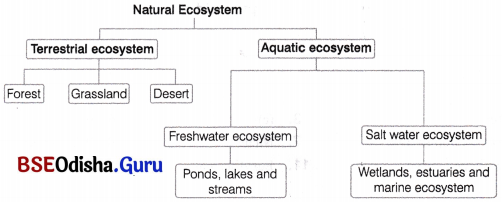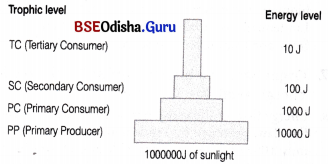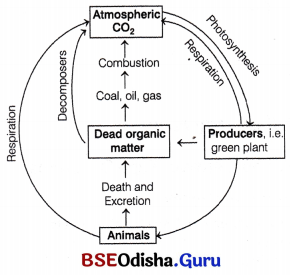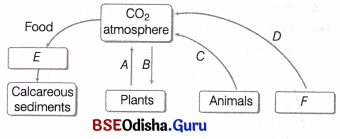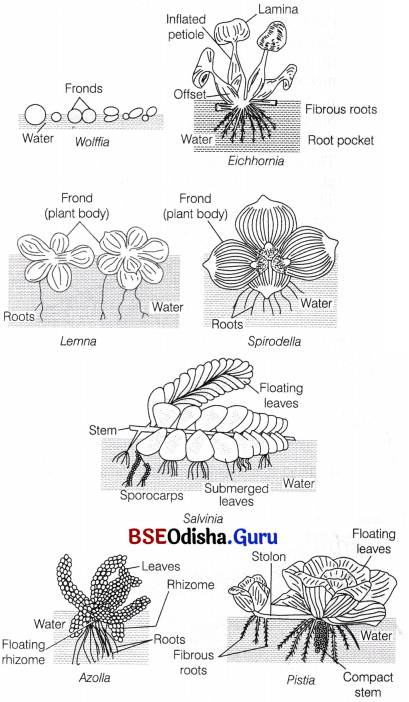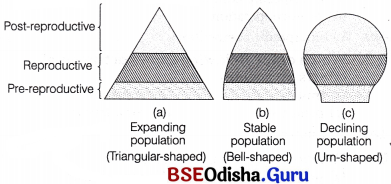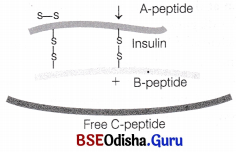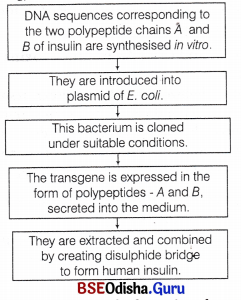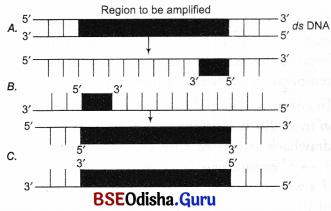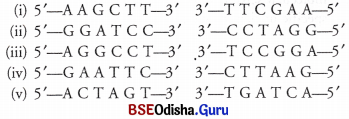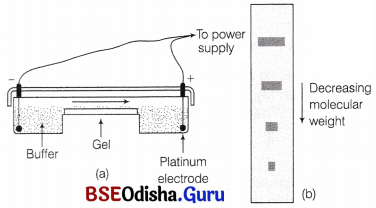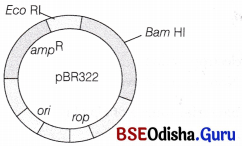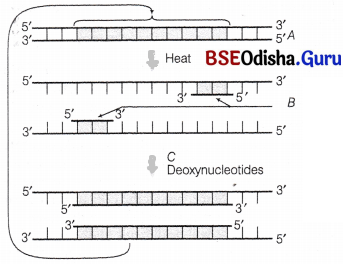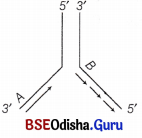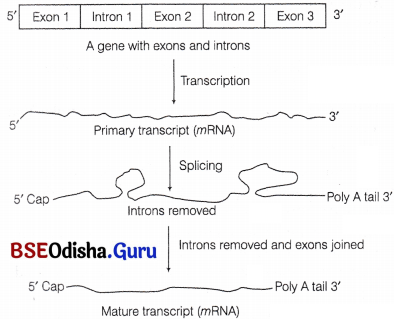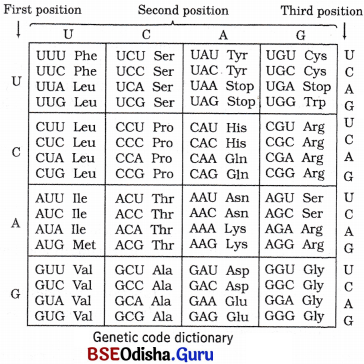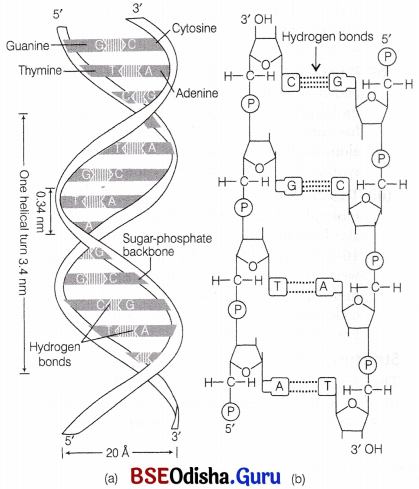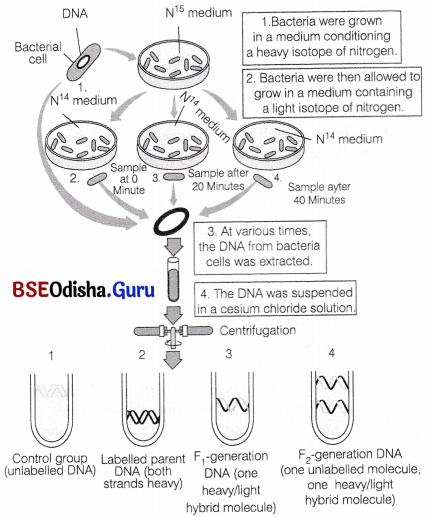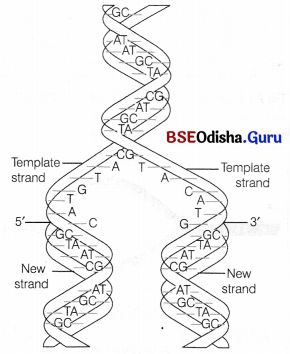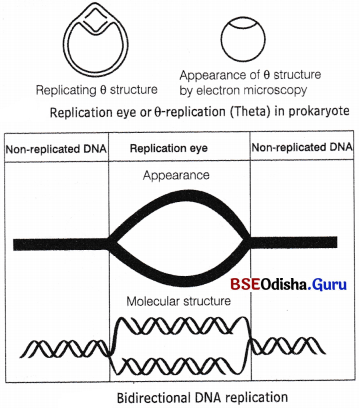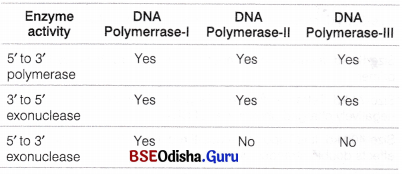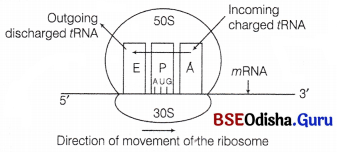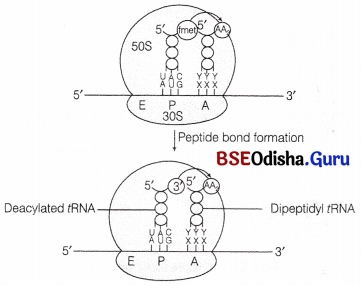Odisha State Board CHSE Odisha Class 12 Biology Important Questions Chapter 17 Environmental Issues Important Questions and Answers.
CHSE Odisha 12th Class Biology Important Questions Chapter 17 Environmental Issues
Environmental Issues Class 12 Important Questions CHSE Odisha
Very Short Answer Type Questions
Choose the correct option
Question 1.
The major pollutant from automobile exhaust is known as
(a) NO
(b) CO
(c) SO2
(d) Soot
Answer:
(b) CO
Question 2.
Which air pollutant could cause rains to be acidic?
(a) Dust particles from cement factories
(b) Insecticides from crop sprays
(c) Smoke from wood fires
(d) Sulphur dioxide from coat-fired power stations
Answer:
(d) Sulphur dioxide from coat-fired power stations
Question 3.
Which process does not result in the return of carbon dioxide to the atmosphere?
(a) Combustion of fossil fuels
(b) Decomposition of humus
(c) Respiration by bacteria
(d) Photosynthesis by green plants
Answer:
(d) Photosynthesis by green plants
Question 4.
Which kind of power station produces sulphur dioxide causing air pollution and acid rain?
(a) Loal-fired
(b) Nuclear
(c) Hydroelectric
(d) Wind-powered
Answer:
(a) Loal-fired
Question 5.
Eutrophication in lakes is the direct result of
(a) a diminished supply of nitrates and phosphates
(b) industrial poisons
(c) nutrient enrichment such as nitrate and phosphate runoffs from the land
(d) an increase in predators
Answer:
(c) nutrient enrichment such as nitrate and phosphate runoffs from the land
Question 6.
Why does the oxygen concentration in the water decrease when sewage is discharged into a river?
(a) Decrease in the number of plants
(b) Increase in the number of fish
(c) Less oxygen absorbed from the air
(d) Rapid growth of bacteria
Answer:
(d) Rapid growth of bacteria
Question 7.
Minamata disease is due to pollution of water by
(a) mercury
(b) lead
(c) tin
(d) methylisocyanate
Answer:
(a) mercury
Question 8.
The effects of radioactive pollutants depend upon
(a) the rate of diffusion
(b) energy releasing capacity
(c) rate of deposition of contaminant
(d) All of the above
Answer:
(d) All of the above
Question 9.
The most harmful types of environment pollutants are
(a) human organic wastes
(b) wastes from faecal
(c) non-biodegradable chemicals
(d) natural nutrients present in excess
Answer:
(c) non-biodegradable chemicals
Question 10.
Taj Mahal is threatened to ……….. the effect of
(a) chlorine
(b) SO2
(c) oxygen
(d) hydrogen
Answer:
(b) SO2
Question 11.
CO is a pollutant because it
(a) inactivates nerves
(b) combines with oxygen
(c) combines with Hb
(d) inhibits growth
Answer:
(c) combines with Hb
Question 12.
Flyash is an environmental pollutant produced by
(a) thermal power plant
(b) oil refinery
(c) fertilisation plant
(d) strip mining
Answer:
(d) strip mining
Question 13.
Which type of pollution is caused by scooters?
(a) Air pollution
(b) Soil pollution
(c) Both (a) and (b)
(d) Water pollution
Answer:
(a) Air pollution
Question 14.
Acid rain occurs in areas where
(a) large plantation occurs
(b) small plantation occurs
(c) there are big industries and the atmosphere is polluted with SO2
(d) there are no industries
Answer:
(c) there are big industries and the atmosphere is polluted with SO2
Question 15.
Air pollution effects are usually found on the
(a) leaves
(b) flowers
(c) stems
(d) roots
Answer:
(a) leaves
Question 16.
Eutrophic lakes are highly
(a) productive
(b) enriched with phosphates
(c) heavy metal
(d) None of the above
Answer:
(b) enriched with phosphates
Question 17.
Global warming can be controlled by
(a) reducing reforestation, increasing the use of fossil fuel
(b) increasing deforestation, slowing down the growth of human population
(c) increasing deforestation, reducing efficiency of energy usage
(d) reducing deforestation, cutting down use of fossil fuel
Answer:
(d) reducing deforestation, cutting down use of fossil fuel
Question 18.
The common refrigerant that is responsible for the depletion of stratospheric ozone is
(a) CFC
(b) NO
(c) SO2
(d) Ozone
Answer:
(a) CFC
Question 19.
Slash and burn agriculture is known as
(a) striping farming
(b) intercrop farming
(c) jhum cultivation
(d) intensive farming
Answer:
(c) jhum cultivation
Question 20.
Ozone hole is the
(a) absence of O3 in stratosphere
(b) presence of O3 in stratosphere
(c) deficiency of O3 in stratosphere
(d) deficiency of O3 in stratosphere
Answer:
(c) deficiency of O3 in stratosphere
Question 21.
Ozone depletion is occurring due to
(a) PCB
(b) CO
(c) PAN
(d) None of these
Answer:
(d) None of these
Question 22.
The most common and abundant greenhouse gas is
(a) methane
(b) CFC
(c) carbon dioxide
(d) nitrous oxide
Answer:
(c) Carbon dioxide
Question 23.
Women empowerment in Tehri-Garhwal by Sundarlal Bahuguna for the conservation of forests is popularly known as
(a) agro forestry
(b) shifting cultivation
(c) Chipko movement
(d) None of these
Answer:
(c) Chipko movement
Correct the following sentences, if required, by changing the underlined word (s)
Question 1.
Acid rain, a secondary effect of sound pollution.
Answer:
air pollution
Question 2.
The excessive growth of plants in water bodies due to enrichment of nutrients is called bioremediation.
Answer:
Eutrophication
Question 3.
Excessive nourishment that causes algal bloom is known as biomagnification.
Answer:
eutrophication
Question 4.
Photochemical smog consists of O2 PAN and NOx.
Answer:
It is Correct
Question 5.
Radioactive pollution is caused by α, ß, γ particles.
Answer:
It is Correct
Question 6.
Ozone hole is present above Antarctica.
Answer:
It is correct.
Question 7.
Greenhouse effect refers to cooling of earth.
Answer:
warming
Question 8.
Nitrogen is a greenhouse gas.
Answer:
Carbon dioxide
Fill in the blanks
Question 1.
Bhopal gas tragedy was due to the release of ……….. gas from Union Carbide’s pesticide plant.
Answer:
methyl isocyanate
Question 2.
The toxic metal that is used as an antiknocking agent in petrol engines of automobiles is ………… .
Answer:
lead (Pb)
Question 3.
The Bharat Emission Norm came into force from ……….. .
Answer:
2000
Question 4.
In a scrubber, the effluent containing sulphur dioxide is passed through spray of ………….. .
Answer:
lime or Water
Question 5.
Most hazardous metal pollutant of automobile exhaust is ……….. .
Answer:
CO
Question 6.
Melting of glaciers is an effect of ………… .
Answer:
global warming
Question 7.
Two greenhouse gases produced by anaerobes are ……….. and ………… .
Answer:
methane, carbon dioxide
Question 8.
In 1980s, the government of India introduced a concept known as ………… .
Answer:
Joint Forest Management
Express in one or two word(s)
Question 1.
The expression that reflects the depleted oxygen content in the extremely polluted water.
Answer:
Biochemical Oxygen Demand (BOD).
Question 2.
Expand DDT.
Answer:
Dichloro Diphenyl Trichloroethane.
Question 3.
Name the gas which was released during Bhopal gas tragedy.
Answer:
Methyl isocyanate
Question 4.
Which metal causes gangrenes?
Answer:
Arsenic
Question 5.
In which year Copenhagen conference was held?
Answer:
2009
Question 6.
In which year was Montreal Protocol signed?
Answer:
1987
Question 7.
Above which region of earth is ozone hole located?
Answer:
Antarctic region
Short Answer Type Questions
Question 1.
State the function of catalytic converter in automobile. Name any two metals used in these converters.
Answer:
Catalytic converters are used in automobiles to reduce the emission of poisonous gases. They convert unburnt hydrocarbons to carbon dioxide and water, carbon monoxide and nitrogen dioxide are converted to carbon dioxide and nitrogen gas respectively.
Question 2.
What are causes of air pollution?
Answer:
The various causes of air pollution are
- Smoke stacks of thermal power plants, forest fires, volcanic eruptions, etc.
- Garbage decomposition releases unwanted gases in the air.
- Excessive use of fossil fuels by automobiles and particulate air pollutants released by industries.
Question 3.
Write a short note on water pollution.
Answer:
Water pollution is any undesirable change in the physical, chemical or biological properties of water that may affect the human beings and aquatic species.
There are various types of water pollutants such as
- Domestic sewage
- Industrial waste
- Agricultural waste
The various effects of water pollution are
- Biomagnification
- Eutrophication
- Increase in Biochemical Oxygen Demand (BOD).
Question 4.
Write short note on algal bloom.
Answer:
Algal bloom is excessive growth of planktonic (free-floating) algae in aquatic bodies due to nutrient enrichment by sewage. It causes fish mortality and deterioration of water quality.
Question 5.
What is BOD?
Answer:
BOD (Biochemical Oxygen Demand) it is the amount of oxygen required by the microorganisms in milligram to breakdown the organic matter in water. Polluted water rises the BOD value of water. Also high BOD causes death of aquatic organisms.
Question 6.
What are the sources of radioactive pollution?
Answer:
Following are the sources of radioactive pollution
- Cosmic rays and radiations
- Nuclear weapons
- Nuclear reactors and fuels
- Radioactive isotopes
- Research and medicines.
Question 7.
Write a note on biomagnification.
Answer:
Biomagnification is defined as the increase in concentration of toxicants at successive trophic levels. Mercury and DDT are well known for biological magnification. Toxic materials cannot be metabolised or excreted. Therefore, they get accumulated in an organism and pass on to higher trophic levels, e.g. DDT accumulates in birds and disturbs calcium metabolism which result in thinning of egg shell. This results in decline of bird population.
Question 8.
Write a note on secondary treatment of sewage.
Answer:
Secondary Treatment of Sewage
1. This treatment is also known as biological treatment because it involves the use of microbes or biota for the treatment of sewage. The effluent from primary treatment is passed into large aeration tanks where it is constantly mechanically agitated and air is pumped into.
2. This air helps in the growth of useful aerobic microbes into floes (masses of bacteria associated with fungal filament to form mesh-likes structures). While growing, these microbes consume major part of the organic matter converting it into mircrobial biomass and releasing lot of minerals. This significantly reduces the BOD (Biochemical Oxygen Demand).
Question 9.
Name an industry which can cause both air and thermal pollution as well as eutrophication.
Answer:
Some of the industries that may cause air and thermal pollution as well as eutrophication are thermal power plants, refineries, smelting and metallurgical processing units, steel mills, fertiliser producing units and the industries using steam or water as coolant. The chemical released from these industries (if rich in nitrogen and phosphorus) may result in eutrophication.
Question 11.
Biological Oxygen Demand or BOD increases with increase in water pollution. In this reference, answer the questions that follows
(i) At a particular segment of the river near a sugar factory, the BOD is much higher than the normal level. What is it indicative of ?
(ii) What will happen to the dissolved oxygen and living organisms in this part of the river?
Answer:
(i) It indicates that the sugar factory releases organic waste in the water body. To degrade the organic matter, microbes utilise the dissolved oxygen in the water, thereby, reducing the levels of dissolved oxygen and increasing the BOD.
(ii) In this part of river, the dissolved oxygen will be depleted making it difficult for aquatic species to survive. It can result in death of fishes in severe cases.
Question 12.
With the help a flow chart exhibit the events of eutrophication.
Answer:
A flow chart showing eutrophication is given below
Stinking eutrophic lake with coloured and turbid water
↑
Loss of species diversity
↑
Death of aquatic animals including fish
↑
Reduced contents of dissolved oxygen
↑
Increase in organic loading of lake
↑
Death of submerged plants due to reduced light
↑
Biological enrichment of water
(algal bloom, planktonic algae and higher plants)
↑
Nutrient enrichment of water
↑
Draining of inorganic nutrients
↑
A young lake
Question 13.
How does algal bloom cause eutrophication of water body?
Answer:
Algal bloom Domestic sewage is rich in nutrients like nitrogen and phosphorus which favours the growth of algae. It causes fish mortality and deterioration of water quality.
Example of a bloom includes red tide.
Question 14.
Why is there a decline in population of fish-eating birds, when the water body is amidst agricultural fields?
Answer:
The reason for decline in fish-eating birds is biomagnification of toxic substances like DDT and other pesticides from the agricultural fields. The pesticides are applied in the fields for protection of crops.
Washed off to water bodies with irrigation water and rain and are indirectly consumed by the fishes entering the food chain. It get(s) accumulated and their concentration increases with each trophic level. Thus, on reaching fish-eating birds, their concentration will be increased many folds.
The high concentration of DDT interferes with calcium metabolism in birds and causes thinning of eggshells and their premature breaking, ultimately causing decline in bird population.
Question 15.
Discuss briefly the following
(i) Radioactive waste
(ii) Defunct ships and e-waste
Answer:
(i) Radioactive waste Radioactive waste is generated from nuclear power plants, nuclear weapon manufacturing facilities, cancer treating hospitals and research laboratories using radioisotopes in investigations. This waste is to be disposed off safely by observing the standard guideline because if it remains for a very long period and continues to emit ionising radiation, it will be extremely hazardous to health of all forms of life.
(ii) Defunct ships Old defunct ships are broken down in developing countries like India, Bangladesh and Pakistan because of cheap labour and demand for scrap metal. These ships however, possess a number of toxic materials like asbestos, lead, mercury and polychlorinated biphenyls. The people involved in ship breaking are exposed to these toxic materials and thus suffer from various diseases. The coastal areas where ship breaking is undertaken also become polluted.
Question 16.
Why does ozone hole form over Antarctica? How will enhanced ultraviolet radiations affect us?
Answer:
In Antarctica, winter months receive no sunlight and thus the temperature is extremely low (-85° C). It facilitates the formation of ice clouds which provide the catalytic surface on which the chlorine atoms react with ozone and degrade it. This happens with the return of sun to Antarctica in springs (September and October). Thus, ozone hole appears over Antarctica mostly during spring.
It is a large area of thinned ozone layer mainly over Antarctic region. At this point, depletion of ozone has occurred more as compared to the rest of the stratosphere.
Question 17.
Write short note on greenhouse effect.
Answer:
It is a naturally occurring phenomenon that is responsible for heating of earth’s surface and atmosphere due to the presence of certain gases in the atmosphere. In the absence of greenhouse gases the average temperature of earth would have been a chill-18° C reather than the present average of 15°C.
These gases radiate heat energy and a major part of which again comes to earth’s surface thus heating it up once again. This cycle is repeated again and again.
High levels of greenhouse gases (CO2, CFCs, etc.) in the atmosphere allow the heat waves to reach earth but prevent their escape and the earth becomes warm.
This gradual continuous increase in the average temperature of surface of the earth causes global warming.
Question 18.
Write note on ozone depletion.
Answer:
It is the wearing out or reduction of the amount of ozone in the stratosphere. A number of pollutants enter into the stratosphere and deplete the ozone layer. These include CFCs, CH4 and N2O. CFCs are widely used as refrigerants. When they are discharged in the lower part of atmosphere, they move upward and reach the stratosphere.
In stratosphere, UV-rays act on them releasing Cl atoms. Cl degrades ozone, releasing molecular oxyen. Cl atoms are not consumed in the reaction. Hence, once CFCs are added to the stratosphere they have permanent and continuous effects on ozone levels.
Question 19.
What is ozone shield?
Answer:
Ozone layer lies in the stratosphere between 10-50 kms above the earth surface. It absorbs 90% of sun’s hazardous UV-radiation and protects plant and animal life. Thus, it is called as ozone shield.
CFC is largely responsible of ozone depletion which causes skin cancer, cataract and weaken immune system.
Question 20.
What is the common household source of CFCs? How these gases affect the ozonalayer?
Answer:
CFCs are widely used as refrigerants. When they are discharged in the lower part of atmosphere, they move upward and reach the stratosphere. In stratosphere, UV-rays act on them releasing Cl atoms. Cl degrades ozone releasing molecular oxygen. Cl atoms are not consumed in this reaction. Hence, once CFCs are added to the stratosphere, they have permanent and continuous effects on ozone levels.
Question 21.
Write, what was the percentage of forest cover of India at the beginning and at the end of 20th century. How different it is from the one recommended by National Forest Policy?
Answer:
In the beginning of the 20th century, the forest cover was about 30% while towards its end it reduced to only 19.4%. The National Forest Policy of India – recommends approximately 67% forest cover for hilly regions including himalayas, while 33% for plains. However, the situation is contrastingly different.
Question 22.
Name any one greenhouse gas and its possible source of production on a large scale. What are the harmful effects of it?
Answer:
Carbon dioxide is a major greenhouse gas. Various human activities such as combustion of fossil fuels, electricity generation, transportation and industries are sources of its large scale production. Excess of CO2 is harmful and considered as a pollutant. It is because it traps longer wavelength IR radiations reflected by earth’s surface, thus causing global warming.
Question 23.
It has been recorded that the temperature of the earth’s atmosphere has increased by 0.6°C.
(i) What has caused this increase?
(ii) Explain its consequences.
Answer:
- Increase in the level of greenhouse gases (CO2,CFCS, etc.) in the atmosphere allow the heat waves to reach earth but prevent their escape and thus, the earth becomes warm.
- Effects of increased temperature are
- Leads to deleterious changes in environment, resulting into odd climatic changes such as El Nino effect.
- Melting of polar ice caps which will cause the rise in sea level and many coastal areas may also get submerged.
Question 24.
How does Jhum cultivation promote deforestation?
Answer:
Forests are the providers of timber, fuel wood and other products. Forests also provide habitat to different groups of plants and animals. Forests are cut down for various purposes. Some of the reasons are as follows
- Urbanisation
- Overgrazing by animals
- Forest fires
- Demand of wood and other forest products
- Jhum cultivation.
Slash and bum agriculture is known as Jhum Cultivation in the North-Eastern states of India. In this method, the farmers cut down the trees of the forest and burn the plant remains.
The ash is used as a fertiliser and the land is then used for farming or cattle grazing. After cultivation, the area is left for several years so as to allow its recovery.
This same process is repeated at some other area. In initial days, there was ample recovery time, but now-a-days with increasing population and repeated cultivation, this recovery phase is done away with, resulting in deforestation.
Question 25.
How can slash and burn agriculture become environment friendly?
Answer:
Slash and burn agriculture can become environment friendly if
- small widely scattered plots are used for cultivation, so that the forest ecosystem will not suffer damage.
- crop rotation is used so that soil does not loose its entire fertility.
- keeping cropping period small and follow up (unplanted) period longer.
Question 26.
What is the main idea behind ‘Joint Forest Management Concept’ introduced by the Government of India?
Answer:
The main idea behind joint forest management concept introduced by the Government of India was involving the local communities in forest conservation. This concept was adopted considering the extraordinary courage and dedication the local people showed in protecting the wildlife through the movements like Bishnoi’s movement in Jodhpur and Chipko Movement in Garhwal Himalayas.
Question 27.
Write a note on deforestation and enumerate its consequences.
Answer:
It is the conversion of forested areas to non-forested areas. Almost 40% forests have been lost in the tropics, compared to only 1% in the temperate region.
According to a report by the World Commission on Forests and Sustainable Development (WCFSD), from 6 billion hectares, 8000 years ago, there is a decline of 3.6 billion hectares in 1999 of the forest cover. Similar results were also given by the Food and Agriculture Organisation (FAO).
In India, at the beginning of the 20th century, forest covered area was about 30% of land, whereas by the end of the century, it reduced to 19.4%. This shows the alarming condition of our country.
The loss of trees due to their increased cutting is note worthy. Some of the effects due to deforestation are as follows
- Increased levels of CO2 concentration in atmosphere.
- Loss of biodiversity due to habitat destruction.
- Disturbed hydrologic cycle.
The Andaman and Nicobar islands are the world’s first evergreen forests. The forests also comprise of local comminutes like the Great Andamanese, the Onge, the Jaracuas and the Sentinelese. But, now their population is decreasing 340 km long. Andaman Trunk road was constructed which went through the evergreen forests.
This resulted in clearing of the forest and the tribal communities like Jaracuas original way of life was eroded.
Question 28.
Why has the National Forest Commission of India recommended a relatively larger forest cover for hills than for plains?
Answer:
It is our moral duty to protect, restore and conserve/preserve the forests as they are highly beneficial for mankind.
In India, around 30% of land was covered by forest in early 20th century, which was reduced to 18-19% by the year 2000. National Forest Commission of India (1988) recommended a relatively large forest cover, i.e. 67% for the hills and 33% for the plains. Recommendation of a large forest area for hills is due to its properties like checking soil erosion, percolation and recharging groundwater, checking landslide and other natural calamities and to maintain the original flora and fauna of hills.
Question 29.
How have human activities caused desertification? Explain.
Answer:
The human activities like deforestation, over-cultivation, unrestricted grazing, poor irrigation practices, result in arid patches of land (deforestation).
When these large barren patches extend and remain unattended for long, a desert is created. Because the formation of fertile top layer of soil takes millions of years, desertification easily takes over.
Question 30.
What do you know about Chipko Movement?
Answer:
Chipko Movement happened in 1974, when local women in Garhwal district of India showed enormous bravery in protecting trees from the axe of contractors by hugging them. This movement was world famous and was globally supported.
Question 31.
Discuss the causes and effects of global warming. What measures need to be taken to control global warming?
Answer:
For causes, effects and control measures of global warming.
It has been estimated by computer application studies that there may be a rise of 3°C by the year 2100 on an average.
The major effects of global warming include
- Climate Earth temperature has increased by 0.6°C during past century, most of it in last three decades. This increased temperature caused changes in precipitation patterns.
- Glaciers and ice caps Scientists have proposed that this rise in temperature causes deleterious changes in the environment, resulting in odd climatic changes. Thus, leading to melting of the polar ice caps and Himalayan snow caps.
- Animals and humans The new warmer temperature conditions lead to eruption of diseases in animals and thousands of species will become extinct in a very short period of time. People from coastal areas will start migrating due to climate change.
- Ocean and coasts The increase in temperature causes melting of polar ice caps and glaciers. This will result in the rise of ocean water level. The increased level of ocean water will cause the submerging of many island nations and coastal cities. The high temperature will cause accelerated vanishing of coral reefs.
- Water and agriculture The increased temperature will cause decreased productivity in agricultural practice.
Question 32.
Discuss briefly the following
(i) Greenhouse effect
(ii) Ultraviolet-B
Answer:
(i) It is a naturally occurring phenomenon that is responsible for heating of earth’s surface and atmosphere due to the presence of certain gases in the atmosphere. In the absence of greenhouse gases the average temperature of earth would have been a chill-18° C reather than the present average of 15°C.
These gases radiate heat energy and a major part of which again comes to earth’s surface thus heating it up once again. This cycle is repeated again and again.
High levels of greenhouse gases (CO2, CFCs, etc.) in the atmosphere allow the heat waves to reach earth but prevent their escape and the earth becomes warm.
This gradual continuous increase in the average temperature of surface of the earth causes global warming.
(ii) Ultraviolet-B It is an electromagnetic radiation which has a shorter wavelength than visible light.
It is a harmful radiation that comes from sunlight and penetrates through the ozone hole to the . earth’s surface. It causes many health hazards in humans. UV-B damages DNA and activates the process of skin ageing. It also causes skin darkening and skin cancer. High levels of UV-B cause corneal cataract in human beings.
Question 33.
What depletes ozone in the stratosphere? How does this affect human life?
Answer:
Ozone in the stratosphere is depleted by CFCs, i.e chlorofluorocarbons, released primarily from refrigerators and other industrial emissions.
This affects the human life as it leads to more exposure of UV-radiation, which is considered to be harmful for health. For effects of UV-radiation on human health.
These radations can cause skin cancer, weaker immunity cataract and loss of plant productivity. The thickness of ozone in a column of air from the ground to the top of the atmosphere is measured in terms of Dobson Units (DU).
Differentiate between the following (for complete chapter)
Question 1.
Biomagnification and Eutrophication.
Answer:
Differences between biomagnification and eutrophication are as follows
| Biomagnification | Eutrophication |
| It is the progressive increase in concentration of non-biodegradable substances in the food chain. | It is the enrichment of the water body with plant nutrients like fertilisers from outside. |
| It is found in all types of ecosystems. | It is found only in aquatic ecosystem and leads to organic loading. |
| It leads to toxicity in higher order consumers. | It leads to death of most animals and plants in the affected water body. |
Question 2.
Deforestation and Reforestation.
Answer:
Differences between deforestation and reforestation are as follows
| Deforestation | Reforestation |
| It is indiscriminate cutting down of trees for human usage. | It involves the planting of new trees in place of the ones cut down. |
| This reduces the green cover of the particular area. | It is to increase the green cover of a deforested area. |
| It leads to decline in habitats and biodiversity. | It is done in order to safeguard biodiversity. |
Question 3.
Point and Non-point sources of water pollution.
Answer:
Differences between point source of water pollution and non-point source of water pollution are as follows
| Point source of water pollution | Non-point source of water pollution |
| It is pollution caused by discharge of effluents at one point. | It is pollution caused by discharge of pollutants over a wide area. |
| Due to large scale entry of pollutants at one point the contamination and harmful effect on quality of water is maximum. | There is some dilution of the effect of pollutants due to large size of area. |
| Treatment plant can be installed in the area of flow of effluents. | Treatment plant is useless for this type of pollution. |
| Other type of control measures are not required. | Control measures are required on a large scale for non-liberation of pollutants. |
Question 4.
Biodegradable pollutants and Non-biodegradable pollutants.
Answer:
Differences between biodegradable pollutants and non-biodegradable pollutauts are as follows
| Biodegradable pollutants | Non-biodegradable pollutants |
| They are those pollutants which are decomposed and degraded by microbes. | The pollutants are not decomposed by microbes. |
| The pollutants are degraded quite rapidly. | They are degraded very slowly. |
| Biodegradable pollutants do not pile up. | They often get accumulated. |
| They can be used to produce energy, manure compost and biogas. | Some of the pollutants of properly separated can be recycled others are not manageable. |
| They become part of rapid-turnover in biogeochemical cycles. | Many of them do not enter biogeochemical cycles. Others are very slow and often toxic. |
| Examples garbage, sewage, livestock. | Examples DDT, BHC, plastics, polyethylene, cans, broken glass, etc. |
Question 5.
Herbicides and Insecticides
Answer:
Differences between herbicides and insecticides are as follows
| Herbicides | Insecticides |
| These are a type of pesticides used to kill undesirable plants or weeds. | These are type of pesticides that are used to specifically target and kill insects. |
| Some herbicides kill all the plants they come in contact with, while others are designee to target one species. | The targets are fixed, e.g. snail bait, ant killer and i wasp killer. |
Question 6.
Acid rain and Global warming.
Answer:
Difference between acid rain and global warming are as follows
| Acid rain | Global warming |
| Acid rain is the name given to rain, snow or sleet contaminated with acid substance. This occurs when the rain water combines with nitric and sulphuric acids. | Global warming is when the earth’s temperature rises. It happens when carbon dioxide, water vapour, nitrous oxide and methane trap heat and light from the sun in the earth’s atmosphere, which increases the temperature. |

